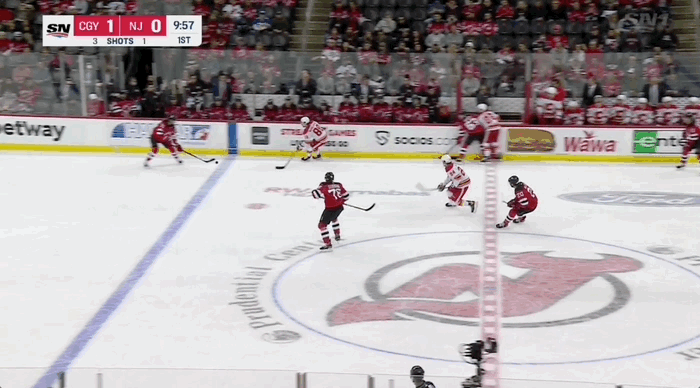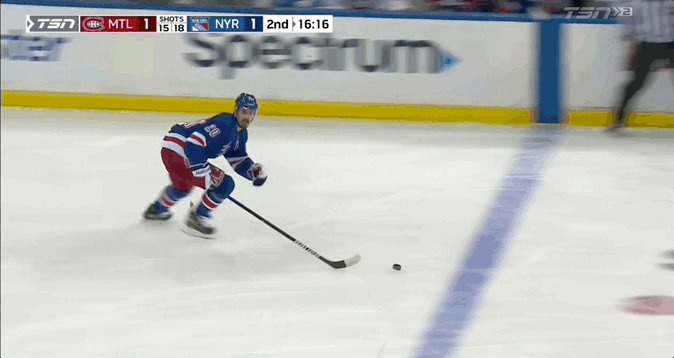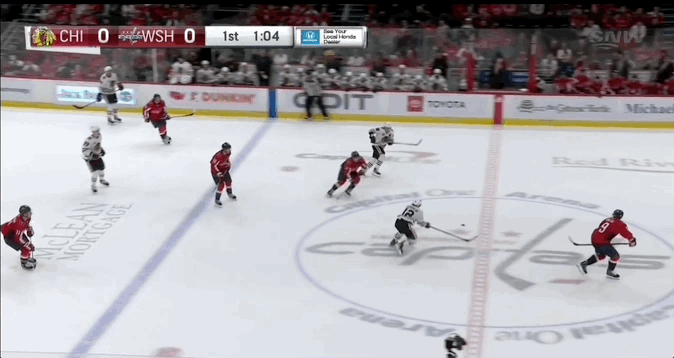If a player racks up a ton of assists, but doesn’t score too many goals, it’s easy to write them off as a one-dimensional scorer. But if a skater keeps tallying goals and isn’t helping their teammates with assists, does the same criticism stand? Probably not, because they’re first on the scoresheet so often.
Through the quarter-mark of the NHL season, a few players have jumped out in hockey’s 2021-22 “Cy Young race”. Building off the list Mike Commito pitched earlier this season, we can look at those players whose point totals have skewed towards goal scoring. The question is which players provide more offensively than their shot, and which are on the path to becoming a true finalist for this ‘award.’
The Leaders
The leaders in this race are obvious, and after Thursday night’s games they’re neck-and-neck with matching 16-3-19 stat lines.
With a goal and an assist against the Kings, Andrew Mangiapane matched Chris Kreider’s totals in New York. These two players lead the league with a plus-13 differential between their goal and assist totals, and their goals make up 84 per cent of their total scoring.
After showing his effectiveness below the surface over the past few seasons, Mangiapane’s efforts are translating up on the scoresheet consistently with 19 points in 23 games — especially at 5-on-5, where 10 of his goals and two assists were scored.

His shot, as evidenced by those tallies, is the highlight of his game. He isn’t the most frequent shooter in the league, or even relative to his team. But he makes the most of his shot opportunities by driving to quality areas of the ice. Most of his attempts this season, in all situations, have been concentrated between the circles and in front of the net. In fact, his rate of slot shots — 12.8 attempts per 60 — ranks fourth in the league to Auston Matthews, Vladimir Tarasenko, and William Nylander. And as the data points show on the heat map below, that’s where Mangiapane’s found quite a bit of success.

But is that all he contributes?
Mangiapane ranks second on the Flames, both in all situations and at 5-on-5, in controlled entries to Johnny Gaudreau; about 33 per cent of those entries lead to a scoring chance. At 5-on-5 in particular (since Mangiapane only plays about 35 per cent of the available ice time on the second power play unit), his passing does stand out relative to his team; he attempts to move the puck to the slot often (although he’s only successful about 26 per cent of the time), and effectively sends the puck south in the offensive zone. The winger’s passes directly lead to shot attempts at the fourth-best rate on the team (and 80th among league forwards).

While goal scoring may be Mangiapane’s bread and butter, it’s not all he contributes.
As for Kreider, his 19 points were tallied in two fewer games than Mangiapane, but when adjusting for his playing time, there’s less of a margin between the two wingers in actual minutes played. While the majority of Mangiapane’s scoring has come at 5-on-5, nine of Kreider’s points were net on the power play — almost exclusively as tips and deflections, which are some of the most dangerous attempts a goalie can face in that situation. Goaltenders are challenged by seeing past Kreider’s 6-foot-3 frame in general, but his hand-eye coordination while in front of the blue paint has paid dividends. Few players deflect as many shots as Kreider on the power play, and he’s among the best at scoring off of them.

Based on his shot type, proximity to the net, and the pre-shot movement before his attempts, Kreider’s individual expected goal total (and rate) is the best of the Cy Young candidates.
Kreider’s among the most frequent shooters in New York; in all situation his attempts rank third of the forward group. And he gets the highest rate of shots on goal on his team. But there’s more than just quantity. All shots aren’t created equally, but Kreider’s are valuable based on where he fires them from. Most of his attempts are concentrated to the home plate area in front of the net, and about 56 per cent of his all-situation attempts come from the slot.

What about the rest of his offensive game?
Kreider isn’t the most frequent 5-on-5 passer. In fact, his offensive zone pass attempts rank 10th among Rangers forwards. He does move up when it comes to distributing the puck to the quality areas, ranking sixth. But his passes don’t usually set his teammates up for a shot; while his raw number of primary shot assists rank fourth on the team, when accounting for his ice time it slips to eighth. And among league forwards, it’s 314th.
The power play is obviously where he’s made such an impact in New York; with the top unit he plays about 73 per cent of the available ice time. There, though, relative to both units, Kreider has one of the lowest pass attempt rates in the o-zone. When he does pass, it’s often to the slot — but his rate is a distance away from the team leader, Artemi Panarin.
Kreider’s contributions, besides his shot, can come before these offensive passing plays. He doesn’t carry the puck in at a leading rate, but a team-leading 32.5 per cent of his attempts lead to a scoring chance. The speedy winger also often brings the puck in with control as the receiver of a pass entry.
So when comparing these two head-to-head, one is more ‘balanced’ than the other below the surface between passing and shooting despite matching scoring stats.

The Contenders
Kreider and Mangiapane obviously are the clear Cy Young standouts at this point in the season. But they’re not the only ones in the race.
What was our criteria besides scoring totals more slanted towards goals? First, we sifted to find players whose goal scoring absorbed around three quarters of their point totals. Then we narrowed it down to those with loftier goal totals, so while we give nods to Kevin Rooney and Oliver Wahlstrom (5-0-5), as well as Anders Lee and Ryan Poehling (4-0-4), we need to see how they sustain this imbalance as they produce more.
Right now, our players include Alex DeBrincat (13-4-17), Boone Jenner (11-4-15), Jared McCann (10-4-14), Brock Nelson (9-2-11), Brandon Saad (9-3-12), and Eetu Luostarinen (7-1-8).

Now, some players’ all-situation shot generation is influenced by their power play usage. As much as we can weigh playing time, we know having an opportunity for quality shots or passes are impacted by situation. Kreider, Jenner, and DeBrincat are all leaned on for top minutes while Mangiapane is deployed on the second unit. McCann’s currently on PP2, but spent time on the top unit this season. Nelson only played about 42 per cent of the available ice time in the games he played, which trends closer to PP2.
But at the end of the day, this is an all-situation award. So while we usually stress 5-on-5 play to keep the playing field equal, that’s not required here. We just want to know what these players contribute in the minutes and role they play.
Of all the contenders, including Kreider and Mangiapane, DeBrincat’s the most frequent shooter, both in quantity and quality, as he shoots from the slot at a high rate; about 59 per cent of his shots come from that area of the ice in all situations.

The Blackhawks’ winger is also a quality passer; he successfully moves the puck to the slot at a top-20 rate in the league in all situations. And while his passes directly lead to shots at the third-highest rate in Chicago, DeBrincat also claims the 65th-highest primary shot assist rate in the league. So, like Mangiapane, there’s a lot more to his game than just this shot — and that will likely boost his assist totals as the season progresses.
Nelson of the Islanders, prior to his injury, also created a high rate of slot shots. That’s contributed to his 1.36 expected goal rate that ranks 25th in the league (behind Kreider, Mangiapane, and DeBrincat). That’s the core of Nelson’s game, though, not his set ups. So when healthy, he could stay in the Cy Young race as long as he doesn’t fall too far behind in actual scoring totals.
McCann, on the other hand, ranks fifth on his team in shot assists. It’s not the highest mark in the league, but neither is his expected goal rate. So it won’t be a surprise if his passing starts appearing more on the scoresheet to balance his point totals.

On the surface, while there are quite a few seemingly one-dimensional players here based on their stats, we know that most generate more than just their shot. But for the Cy Young award in hockey, we also can see a true front-runner who relies on his shot a lot and is likely to continue building on his imbalanced scoring total. Kreider’s leading this pack of forwards in the 2021-22 Cy Young award of the NHL, and could continue as the season (and this race) develops.
Data via Sportlogiq
[relatedlinks]































COMMENTS
When submitting content, please abide by our submission guidelines, and avoid posting profanity, personal attacks or harassment. Should you violate our submissions guidelines, we reserve the right to remove your comments and block your account. Sportsnet reserves the right to close a story’s comment section at any time.